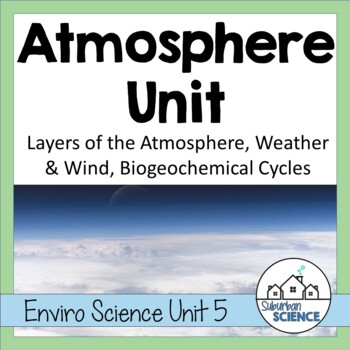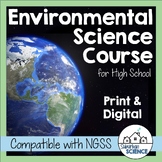Environmental Science Unit: Atmosphere, Weather, Wind & Biogeochemical Cycles
- Zip
What educators are saying
Also included in
- These environmental lesson plans will help your students to take charge of their learning! This comprehensive course is interactive, hands-on, and student-centered! Students learn about major environmental issues in modern society through detailed lessons and activities. Units cover the four sphePrice $250.00Original Price $276.00Save $26.00
Description
This is a bundle of environmental and earth science lessons on the composition and layers of the atmosphere, global wind and climate patterns, and biogeochemical cycles. Human impacts on the environment are interwoven through each lesson to provide students with a good basis for any environmental science or APES course. A PowerPoint, guided notes, web-quests, doodle notes, activities, extension pages, and assessments are all included in this lesson. All student pages come in both PRINT and DIGITAL versions for efficient use in class or through distance learning.
➤PLEASE NOTE: This unit is also included in my FULL ENVIRONMENTAL SCIENCE CURRICULUM.
➤What's included?
-10 Teacher Planning Pages (standards document, editable daily pacing guide, differentiation ideas for student interest, ability, and learning environment)
-1 PowerPoint (49 editable slides- highly visual and fully animated)
-6 pages of Cornell Notes (both fill-in-the-blank and editable versions included)
-3 web-quests with corresponding student pages for independent learning
-3 pages of my popular Doodle Notes(TM) and a guide to using them in your classroom
-7 Activities:
- Composition of the Atmosphere lab
- Layers of the Atmosphere graphing activity
- Exploring the Coriolis Effect partner activity
- Local Weather independent exploration
- Meteorology Video Report group activity
- What's Your Weather? independent exploration
- Nitrogen Cycle Board Game
-8 Extension pages:
- 4 Digging Deeper extensions for increased depth of knowledge & critical thinking skills (The Ozone Layer, Deforestation, ENSO, Greenhouse Gases)
- 4 Data Analysis extensions to focus on interpretation of graphs & math integration (Atmospheric Composition, Atmospheric Pressure, Solar Insolation, Carbon Residence Time)
-1 quiz through Google Forms for automatic online grading
-24 editable task cards for a quick and easy unit review
-Editable unit test with multiple-choice and short answer questions (in both honors and regular versions)
-Supplementary Resource Ideas: links and videos for additional explanation or exploration
-Answer keys and grading rubrics for all student pages
➤What topics are included in this unit?
Composition & Layers of the Atmosphere
- Atmospheric composition
- Composition of early atmosphere
- Layers of the atmosphere (troposphere, stratosphere, mesosphere, thermosphere, exosphere)
- Temperature trends in each layer of the atmosphere
- Function and importance of ozone layer
Weather
- Tilt of the earth, seasons, and solar radiation
- Global circulation (Polar cells, Ferrel cells, Hadley cells)
- Coriolis Effect
- ENSO (El Nino, La Nina)
- Weather maps (isothermic, isobaric, streamline, humidity)
- Effects of deforestation on local and global weather
Biogeochemical cycles
- Nutrient sources, sinks, and reservoirs
- Nitrogen cycle (processes and sinks)
- Phosphorous cycle (processes and sinks)
- Carbon cycle (processes, reservoirs, and sinks)
- Human impacts on the nitrogen, phosphorous and carbon cycles
- Greenhouse gases and global warming (climate change)
The unit is aligned to NGSS and many state standards. If you’d like to know whether your state standards are covered, you can send me an email at support@suburbanscience.com. Additional details on standards are included in the teacher planning pages of this course.
________________________________________________________________________
*For more details about the specific topics and items included, please see my PREVIEW.*
➤Where can I find other Environmental Science lessons?
Intro to Environmental Science
Biosphere Unit 1: Ecology, Food webs, and Symbiosis
Biosphere Unit 2: Species and Population Ecology
Biosphere Unit 3: World Biomes, Ecological Succession, and Biodiversity
Atmosphere: Weather, Wind, and Biogeochemical Cycles
Geosphere Unit 1: Plate Tectonics and Landforms
Geosphere Unit 2: Minerals, Mining, and Soil
Geosphere Unit 3: Fossil Fuels and Renewable Energy
Hydrosphere Unit 1: Surface Water, Groundwater, and the Water Cycle
Hydrosphere Unit 2: Marine Biomes and Water Pollution
Or get the Full Environmental Science Curriculum which includes all these units!
➤What curriculum could I use with this lesson?
This lesson is ideally geared toward high school students and would work well with a general-level Environmental Science or Biology textbook. It addresses the following topics in AP Environmental Science (APES):
- 1.4: The Carbon Cycle
- 1.5: The Nitrogen Cycle
- 1.6: The Phosphorus Cycle
- 4.4: Earth's Atmosphere
- 4.5: Global Wind Patterns
- 4.7: Solar Radiation and Earth's Seasons
- 4.8: Earth's Geography and Climate
- 4.9: El Niño and La Niña
- 9.1: Stratospheric Ozone Depletion
- 9.2: Reducing Ozone Depletion
- 9.3: The Greenhouse Effect
➤Can I edit these resources to fit my needs?
Some of the files in this unit are editable. The text on the PowerPoints, Cornell Notes, and task cards is all editable so you can adjust the level of content and wording. The pacing guide, printable unit tests, and online quizzes through Google Forms™ are all fully editable. Web-quests, activities, extension pages, and any images included in this unit are in non-editable PDF formats to protect my intellectual property rights and those of the illustrators whose images I’ve purchased for use in this resource.
________________________________________________________________________
⭐For updates about sales and new products, please follow my store: My TpT Store
You can also
⭐Subscribe to my newsletter for freebies and teaching tips
⭐Follow me on Instagram
⭐Check out my Facebook page
⭐Follow me on Pinterest
I value your feedback. Please rate this product. If you have any issues or questions about this product, please feel free to ask a question in my store or write to me at support@suburbanscience.com.






